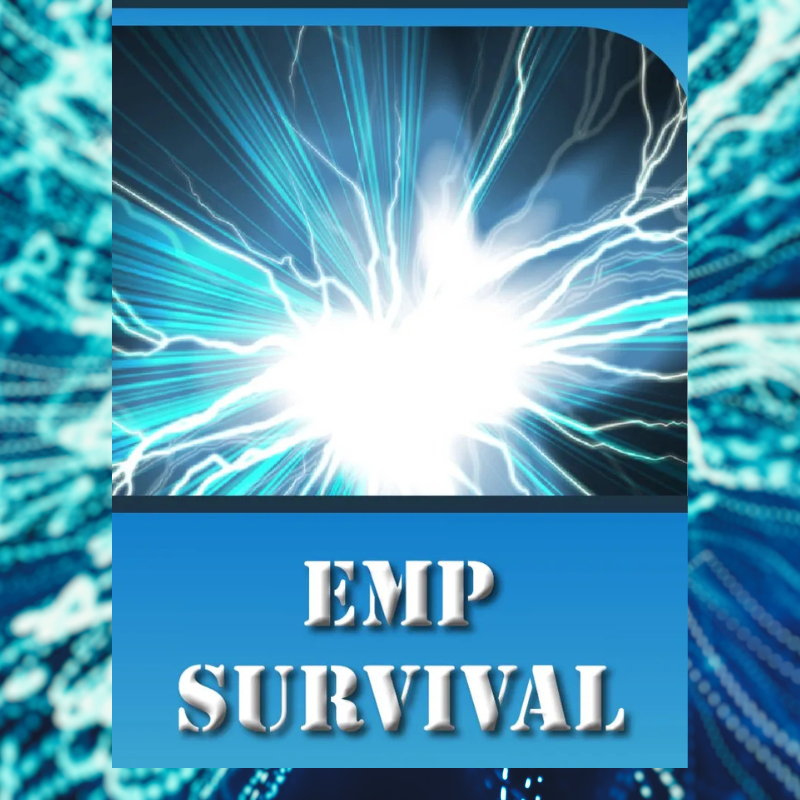Prepare for the unexpected with the EMP Blackout Protocol Survival System. This comprehensive survival guide equips you with essential knowledge and strategies to protect yourself and your loved ones during an electromagnetic pulse event. Discover practical tips on food storage, self-defense, and communication methods to ensure your safety and resilience. The system emphasizes actionable steps, making it easy to implement in any situation. Don’t wait for a crisis to strike; invest in your peace of mind today. Choose the EMP Blackout Protocol and take control of your survival strategy in an uncertain world.
Description
Electricity powers nearly everything in our modern lives. From communications and food storage to transportation and medical systems, every essential infrastructure depends on the electrical grid. But what if that grid went down — not for hours, but indefinitely?
That scenario forms the basis of what many refer to as the EMP Blackout Protocol, a comprehensive survival framework designed to prepare households for the unthinkable: a complete and prolonged loss of power following an Electromagnetic Pulse (EMP) or related grid-collapse event.
This in-depth research article explores what EMPs are, how they can occur, their potential impact on society, and what steps ordinary people can take to prepare, survive, and rebuild in a post-blackout world.
Understanding EMPs and Why They Matter
An Electromagnetic Pulse (EMP) is a burst of electromagnetic energy that can result from either natural or man-made sources.
- Natural EMPs are usually caused by massive solar flares or coronal mass ejections (CMEs) emitted by the sun. When these energetic waves hit Earth’s magnetic field, they can induce currents in power lines and electronics.
- Man-made EMPs result from high-altitude nuclear detonations or specialized non-nuclear EMP weapons designed to disrupt electrical systems.
Both types have the same end result: massive surges in electricity that overload circuits and destroy unprotected electronics.
If an EMP were to strike today, the power grid could collapse within seconds, disabling:
- Power plants and substations
- Communications networks
- Banking systems and ATMs
- Water treatment and sewage systems
- Transportation infrastructure
Without immediate recovery systems, entire cities could plunge into darkness — and chaos — within hours.
The EMP Blackout Protocol: What It Is
The EMP Blackout Protocol Survival System refers to a structured preparedness framework built around three primary goals:
- Protection – Safeguard people, data, and essential electronics from EMP-induced failure.
- Sustainability – Create off-grid capabilities for food, water, heat, and communication.
- Resilience – Develop physical and psychological readiness to endure prolonged infrastructure collapse.
This concept doesn’t rely on fear — it’s about self-reliance. It provides a systematic plan to handle life without power for days, weeks, or even months, while ensuring safety, stability, and long-term adaptability.
How an EMP Blackout Could Affect Modern Civilization
1. Power and Communication Loss
Electricity would be the first casualty. Transformers, substations, and even household appliances could fry instantly. Communication networks — including cell towers, the internet, and GPS — would fail. Emergency responders would be blind and deaf.
2. Transportation Halt
Modern vehicles rely on computer chips and sensors. An EMP could disable most cars manufactured after the mid-1990s, leaving millions stranded. Air travel and shipping would come to a halt, disrupting global supply chains.
3. Banking and Economy
With no access to online banking, credit cards, or ATMs, cash becomes the only immediate currency. Within days, stores would run out of supplies and chaos could follow as people panic-buy remaining resources.
4. Food and Water Shortages
Supermarkets depend on just-in-time supply chains. Without refrigeration or transport, food spoils quickly. Municipal water systems, reliant on electric pumps, would stop functioning, forcing people to rely on whatever reserves they have.
5. Healthcare and Safety Risks
Hospitals could lose access to life-support equipment and refrigeration for medicines. Without law enforcement communications or security systems, crime rates could spike.
Phase 1: Protection — Securing Electronics and Power
The first step of the EMP Blackout Protocol is protection. While total immunity from an EMP is impossible, damage can be minimized with proper shielding and redundancy.
1. Build or Buy a Faraday Cage
A Faraday Cage is an enclosure made of conductive material that blocks electromagnetic fields. You can create one using:
- A metal trash can lined with cardboard
- Aluminum mesh or foil-wrapped containers
- Specialized EMP-proof bags or lockers
Inside, store essential electronics like:
- Emergency radios
- Solar-powered chargers
- Flashlights
- Backup hard drives
- Laptops or tablets (for offline manuals and maps)
2. Shield Your Vehicle
Older, non-computerized vehicles (pre-1980s models) are naturally resistant to EMP damage. If using modern vehicles, consider keeping spare electronic control units (ECUs) stored in a Faraday enclosure.
3. Protect Power Sources
Invest in portable solar generators with surge protection or manually operated devices. Solar panels are less vulnerable if disconnected from circuits during an EMP event.
Phase 2: Sustainability — Living Off the Grid
After an EMP, returning to “normal” may take weeks or years. A sustainable lifestyle becomes crucial.
1. Water
Water is your top priority. Without electricity, water treatment and pumping stop.
Store at least one gallon per person per day for two weeks. Beyond storage, develop renewable water sources:
- Rainwater collection barrels
- Manual hand pumps for wells
- Portable water filters and purifiers
2. Food
Aim for a six-month emergency food supply including:
- Shelf-stable items (rice, beans, oats, canned vegetables, jerky)
- Freeze-dried or dehydrated meals
- Seeds for home gardening (tomatoes, lettuce, beans, herbs)
- Cooking gear such as rocket stoves or solar ovens
Rotating stock ensures freshness and avoids waste.
3. Shelter and Heating
With grid failure, heating and cooling become serious threats.
- Use propane or wood stoves for winter heat.
- Invest in thermal blankets, insulated clothing, and fire-starting kits.
- In hot climates, rely on airflow ventilation and shade-based cooling structures.
4. Lighting and Power
Solar lanterns, LED lamps, and hand-crank flashlights are essential. A small solar generator can power radios, phones, and minimal medical devices.
5. Sanitation
Lack of waste disposal can trigger health crises.
- Build composting or bucket toilets with sawdust or lime.
- Stock disinfectants and biodegradable soap.
- Designate an outdoor hygiene area away from living quarters.
Phase 3: Resilience — Mental and Community Readiness
Survival isn’t only physical — it’s psychological and social.
1. Mental Preparedness
Understand that fear, panic, and hopelessness are natural but manageable.
- Practice mindfulness, journaling, and breathing exercises.
- Establish routines to preserve normalcy.
- Maintain a sense of purpose through daily tasks and small victories.
2. Family Planning
Every family member should have a role: water duty, cooking, communication, or security. Conduct regular drills and ensure everyone knows emergency contacts and meeting points.
3. Community Alliances
No one survives indefinitely alone. Building trust and collaboration with neighbors ensures better outcomes. Share skills like first aid, gardening, or mechanics. Pool resources and maintain collective security.
The Science of Recovery After an EMP
An EMP itself lasts only seconds, but recovery takes months or years. Repairing the grid involves:
- Replacing high-voltage transformers (which take months to manufacture)
- Rebuilding communication networks
- Restoring industrial control systems
The key advantage of being prepared is bridging the gap until infrastructure recovers. Those who can sustain themselves during the blackout become anchors of stability for others.
EMP Myths vs. Facts
| Myth | Fact |
|---|---|
| EMPs instantly destroy everything electronic | Impact varies by strength, distance, and shielding. Small electronics can survive with protection. |
| Only nuclear weapons can cause EMPs | Solar storms and localized EMP devices can cause similar disruptions. |
| Governments have complete protection | Many systems remain vulnerable; only military infrastructure has partial EMP hardening. |
| Preparation is too expensive | Basic measures like food storage, water filtration, and DIY Faraday cages are affordable. |
| Survival is hopeless | Knowledge, mindset, and planning make survival highly possible. |
Practical Everyday Preparations
- Emergency Kits — Include first aid, tools, water purification tablets, and nonperishable food.
- Offline Knowledge Library — Download and print guides on gardening, medical care, and mechanical repairs.
- Alternative Energy Sources — Small solar setups, wind turbines, or hand-crank generators.
- Cash and Barter Items — Keep small denominations and trade goods (batteries, lighters, canned food).
- Security Tools — Flashlights, radios, and simple defensive equipment to deter theft.
- Fuel Storage — Keep limited reserves of propane, diesel, or firewood (stored safely).
EMP-Proof Communication Strategies
Communication determines survival coordination. Since most cell towers and satellites would go offline, redundancy is key.
- HAM Radio (Amateur Radio): The backbone of off-grid communication; licenses are easy to obtain.
- Walkie-Talkies / Two-Way Radios: Short-range contact between team members.
- Signal Flags and Whistles: Simple but effective for close-proximity signaling.
- Pre-Arranged Codes: Use physical signals (chalk marks, color-coded flags) for stealth messaging.
Store all critical communication devices inside your Faraday cage when not in use.
The Psychological Curve of Long-Term Blackouts
Survival experts often refer to the “Rule of Threes”: three minutes without air, three days without water, and three weeks without food. But when a blackout stretches into months, the psychological timeline matters most.
- Phase 1 – Shock (Days 1–3): Confusion, disbelief, and adrenaline. People panic.
- Phase 2 – Adaptation (Weeks 1–4): Routines form; communities organize.
- Phase 3 – Resilience (Months 1–6): Creativity and barter economies emerge.
- Phase 4 – Renewal (6+ Months): Reconstruction and new systems begin.
Preparedness training shortens the chaos phase and accelerates stability.
The Role of Skill-Building
Knowledge outlasts any gadget. The EMP Blackout Protocol emphasizes hands-on survival skills:
- Fire Starting — Matches, lighters, ferro rods, and natural tinder.
- Navigation — Map and compass reading, celestial navigation.
- Medical Skills — CPR, wound care, herbal medicine basics.
- Gardening and Food Preservation — Composting, seed saving, canning.
- Mechanical and Electrical Repair — Rebuilding small devices or off-grid systems once safe.
Every skill learned before a crisis multiplies survival chances after it.
Energy Alternatives in a Gridless World
To sustain life after a blackout, energy diversification is crucial.
1. Solar Energy
Small, modular systems can power lights, radios, and small appliances. Keeping panels disconnected during an EMP minimizes risk.
2. Manual Power
Hand-cranked devices — flashlights, grinders, washing machines — reduce reliance on electricity.
3. Biomass and Fire Energy
Wood, charcoal, and biofuel provide heating and cooking.
4. Wind and Water Power
If geography allows, micro-turbines can generate steady, low-voltage power.
Rebuilding After the Blackout
Once stability returns, communities transition from survival to rebuilding. The focus shifts to:
- Repairing local energy systems (solar, wind, microgrids)
- Restoring agricultural production
- Developing trade networks
- Reestablishing education and healthcare
Prepared individuals often become the foundation of this new society — teaching, organizing, and stabilizing local economies.
Frequently Asked Questions
1. What’s the difference between a solar flare and a man-made EMP?
A solar flare is a natural geomagnetic storm that induces currents globally. A man-made EMP is more concentrated and instantaneous, usually caused by a nuclear or directed-energy event.
2. Can I protect my home completely?
Total protection isn’t possible, but partial shielding and redundancy significantly reduce vulnerability.
3. How long would it take for the grid to recover?
Estimates vary, but experts suggest weeks to months for localized events, and years for widespread, high-intensity EMPs.
4. What should I prioritize first?
Water, food, and protection from the elements. Once basic needs are secure, focus on communication and power.
5. Is this level of preparation realistic?
Yes — even modest steps like stocking supplies and learning first aid dramatically improve survival odds.
Conclusion: The Power of Preparedness
The EMP Blackout Protocol Survival System isn’t about predicting disaster; it’s about preventing panic. It empowers individuals and families to respond intelligently to a prolonged power crisis.
By understanding how EMPs work, protecting critical systems, and adopting sustainable off-grid practices, anyone can transform fear into readiness.
Modern civilization’s greatest vulnerability is its dependency on power — but the human spirit, when trained and prepared, is stronger than any outage.
When light fades and the grid goes silent, those who planned ahead will not just survive — they will lead.




